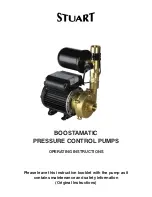
Page 13/43
Firemiks AB
Instruction manual version: SPFA FM
P.O. Box 8155, 104 20 STOCKHOLM, Sweden
phone +46-8-551 196 10 - [email protected] - www.firemiks.com
4.3.9
Note! It is extremely important that a shut-off valve is installed before
the FIREMIKS unit.
This is to ensure a risk-free service/maintenance, i.e. the
risk for sudden rotation of the water motor due to unexpected water flow will
be eliminated by closing this valve. When working on the FIREMIKS, put a
clear sign on this valve stating:
“Do not open, maintenance work in progress”.
4.3.10 In the case that the pressure capacity of the pumping system is higher than
the maximum rated pressure of the FIREMIKS unit, it is recommended that a
pressure-relief valve is installed in the main system.
4.3.11
Note! As in all safety-related installations, there should always be a
back-up plan
. Never design the installation in such a way so that the water
flow through the FIREMIKS is the only source for fire-fighting water.
4.3.12 If the installation is to also operate with extinguishing water only by design (no
dosing),
a by-pass should be installed and used around the FIREMIKS
system
to avoid unnecessary wear of the unit. If the system has to run with
extinguishing water through the FIREMIKS (no dosing) by exception for a
short time (less than 10 min), be sure that the Selector valve Dosing/Flushing
(No. 4 on Flow chart) is in the Flushing position to avoid dry running of the
pump.
4.3.13 For wet pipe systems it is recommended to install a drain valve after the
FIREMIKS unit with a capacity of about 100 - 200 lpm to facilitate the rotation
of the water motor according to the maintenance instructions, see 7.3.4
4.3.14 It is possible, with only one main water pump, to design the piping system so
there is plain water from some outlets in the system and at the same time
additive admixed water from other outlets. The requirement is that the
minimum and maximum flow limits on the FIREMIKS are kept.
4.3.15
The outlet system after the FIREMIKS can be divided in many different ways,
also vary in heights, as long as the min. and max. flow limitations of the
FIREMIKS are kept.
4.3.16
Importance of positioning before dosing is reached.
If the concentrate is
available at the pump inlet of the FIREMIKS, it only takes a few seconds of
rotation of the FIREMIKS unit before the concentrate is dosed into the water
at the outlet of the FIREMIKS unit. However, if the FIREMIKS is placed far
away from the discharge devices, it can take a long time before the mixture
had travelled through the piping and the foam is discharged. Without the need
of an external energy source other than the water flow to drive the FIREMIKS
unit, and if it is allowable and practical to have the concentrate tank remain
close to the FIREMIKS unit, it could be possible to move the FIREMIKS and
concentrate tank closer to the discharge devices to reduce this time before
foam discharge. If there are many discharge points, for this reason it could
also be more favorable to have several smaller decentralized FIREMIKS units
with their own concentrate supply instead of one centrally located larger unit.
Short response time can be critical to the outcome of a fire, and a good
system design using FIREMIKS could be the way to achieve this.














































